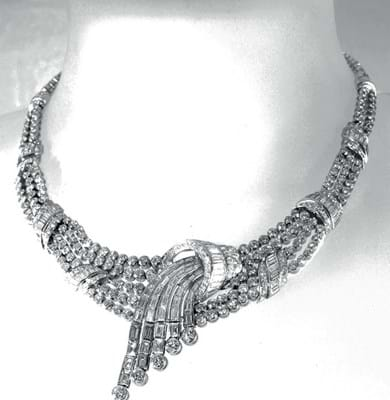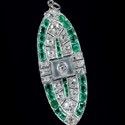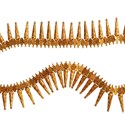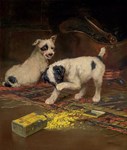Jewellery is an ideal indulgence – and plenty of it is available to choose from at the event, which runs from January 10-13 at the London Marriott Hotel Grosvenor Square, London, as well as fine art, furniture, ceramics and other antiques.
But while rings and earrings are inevitably in demand, the new year could be the perfect opportunity for some buyers to start looking for that perfect necklace too.
Rare breed
“Necklace buyers are a rare breed,” says Edmund Flaxman Johnson of Flaxman Fine Jewellery. “One reason it can be harder to sell these is that it’s difficult to show what they really look like in a display and I wish people would be a bit more adventurous, once you get them on, they look incredible, but people can be scared to try them.”
One of the highlights on his stand is a cascading diamond necklace mounted in platinum made in the US c.1955. Although not signed, it was likely made for a wealthy and important individual, consisting of 40cts of round brilliant cut diamonds mounted in platinum and was probably made in a New York or New Jersey workshop. It comes from a US collection.
The necklace, Johnson says, is typical of post-war pieces, which used forms inspired by nature in reaction to the experience of conflict.
The central part of the piece features a waterfall effect.
Drawn to the unusual
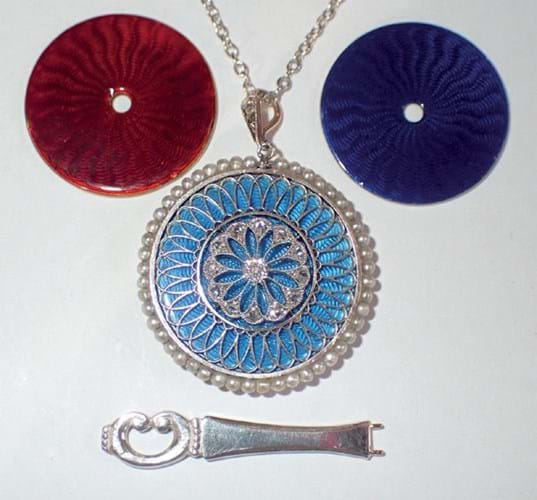
This English 18ct gold and platinum, pearl and diamond pendant with interchangeable guilloche enamelled discs and original fittings, pat no 23105, dated Oct.6th 1910 is on the stand of T Robert for £8450.
Meanwhile, fellow exhibitor Terrence Robert of T Robert specialises in pre-1930s jewellery, fine silver and object d’art and emphasises that his collectors are drawn to the unusual such as an 18ct gold and platinum, pearl and diamond English pendant, c.1910, which he brings to the fair. It features a set of interchangeable guilloche discs applied by unscrewing the back and fitting in the desired disc.
For Robert, it is important to bring pieces which he describes as “wearable, not ostentatious, proper antique jewellery”. Recently he has found that belle epoque pieces of c.1910-16 have been particularly popular, a trend he attributes to various reasons including the popularity of Downton Abbey. This jewellery features “phenomenal” workmanship – something which became more difficult to replicate with falling numbers of workers during and after the First World War.
From a 1760s suite of garnets to a pair of 1980s Cartier earrings, Wimpole Antiques offers a huge range of period jewellery. The dealership’s Lynn Lindsay says that in the past few years there has been a move toward buying coloured stones.
“Today people see the beauty in different stones such as rubies and emeralds. For a while they were considered the poor brothers of diamonds,” Lindsay says, adding that rising demand means the price of emeralds and rubies has increased by around 40% in the past year.
She offers a range of necklaces and pendants including an early Art Deco rock crystal, diamond and emerald pendant.
“It’s a typical 1920s piece, the sort of thing a flapper girl would have worn – probably on a longish chain to hang in the cleavage,” Lindsay says. “It’s Art Deco in style but still fairly fine in construction. Such pieces became heavier towards the war.”
Other highlights around the fair include a 19th century mullai mottu malai made in Tamil Nadu, India, offered by Markov, and an amber torsade necklace, c.1989, by Paloma Picasso for Tiffany, offered by Anthea AG Antiques.
Necklace choices

Available for £10,000 from Gråsilver, Flowering Wall is an 18ct gold Lapponia and tourmaline necklace designed by Björn Weckström of Finland in 1965.
When selecting the right piece, it is important to know when and with what the piece might be worn, which will help determine the style and length to choose. Many necklaces are art pieces in their own right, which can make the thought of wearing them an anxious business. In fact, even museum-quality pieces were made to be worn.
Such is the case with Flowering Wall, an 18ct gold Lapponia and tourmaline necklace designed by Björn Weckström of Finland in 1965.
It was entered in the 1965 international jewellery contest in Rio de Janeiro where it won the Grand Prix, helping Lapponia company gain worldwide recognition. It is offered at the fair by Scandinavian jewellery specialist Gråsilver.
“Weckström was an artist, sculptor and furniture designer and his jewellery is considered art pieces. Not many examples of Flowering Wall were made but it could be worn,” says the dealership’s Jacquie Gray.
“People like pieces that are unique and you wouldn’t find anyone else wearing this at a cocktail party.”
The fair is organised by the Antiques Dealers Fair Limited.


